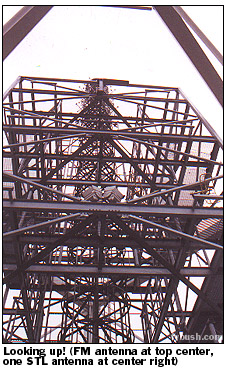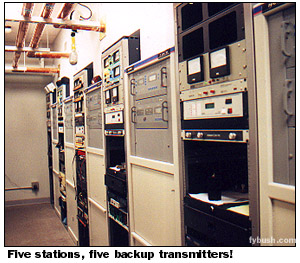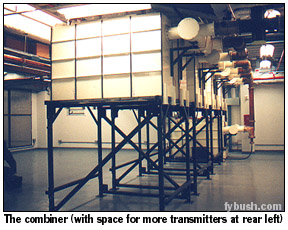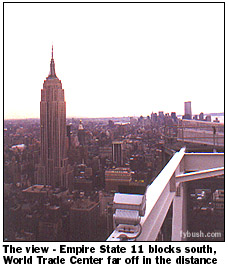
|
|
FYBUSH.COM/SITE OF THE WEEK
NEEDS YOUR SUPPORT! (AND YOU CAN GET A FREE TOWER SITE CALENDAR
IF YOU PLEDGE NOW...) CLICK HERE TO
LEARN MORE...
October 23-30, 2003
A NERW Encore: Four Times Square, January 2001
(Editor's Note: Tower Site of the Week's entire editorial staff will be on vacation for the next couple of weeks, tracking down more exciting towers and antennas in the Great American Midwest, everywhere from Toledo to West Michigan to the very tippy-top of Chicago's Sears Tower. In the interim, we'll present several encore Tower Sites, as well as one new update on October 30. In this week's encore, originally presented here February 28, 2001, your editor visited New York's brand new Four Times Square tower. Note the date: at the time, who could have imagined just how important this auxiliary space would become in a few months?
 Last week, we visited
the Empire State Building and took a trip back into FM radio's
past in New York City. (You'll see an encore
of that visit in this space November 6!) This week, we
look instead toward the future. Welcome to Four Times Square,
the new skyscraper on West 42nd Street that serves as world headquarters
for Conde Nast, parent company of the New Yorker and other
fine magazines.
Last week, we visited
the Empire State Building and took a trip back into FM radio's
past in New York City. (You'll see an encore
of that visit in this space November 6!) This week, we
look instead toward the future. Welcome to Four Times Square,
the new skyscraper on West 42nd Street that serves as world headquarters
for Conde Nast, parent company of the New Yorker and other
fine magazines.
Unbeknownst to all those editorial types, high above them sits one of the most sophisticated multi-station FM sites in America.
Clear Channel's five New York stations (WHTZ 100.3, WKTU 103.5, WAXQ 104.3, WTJM 105.1 and WLTW 106.7) began building this site even before the rest of the building was finished. In fact, the design of this FM facility was taking place alongside the design of the building itself during 1999.
Yet for all that effort, most of the time there's not a watt of FM power radiating from the Shively antenna that crowns the decorative square tower frame shown to the left. That's because this is an auxiliary facility, designed to keep the five stations on the air in the event of antenna maintenance or power failures at their main sites (Empire State for all the stations save WKTU, which uses the World Trade Center.)
Backup sites like this are increasingly important for two reasons: first, because the massive amounts of revenue generated by big FM stations in the number-one market make the loss of advertising time an expensive proposition; second, because strict new RF radiation guidelines make it harder for the stations at Empire to use the old Alford backup master antenna (it's too close to the observation decks, themselves a source of revenue also too expensive to interrupt!)
Building a brand-new facility meant a lot of brand-new equipment, of course -- Harris Platinum Series Z10 transmitters for each station, along with processing, transmission, and STL gear.
The master antenna itself, though mounted on a rather fancy decorative mast, is a standard-issue Shively broadband model.
 It's a tribute to
modern solid-state equipment that each of these five stations
takes up just two racks in the relatively small room that houses
all the Clear Channel backup transmitters. Behind the row of
racks is a chiller unit (though the new transmitters run quite
cool), with a small engineering bench out of camera range to
the right.
It's a tribute to
modern solid-state equipment that each of these five stations
takes up just two racks in the relatively small room that houses
all the Clear Channel backup transmitters. Behind the row of
racks is a chiller unit (though the new transmitters run quite
cool), with a small engineering bench out of camera range to
the right.
Outside the small transmitter room is the Shively combiner unit, which currently contains modules for the five Clear Channel stations, with capacity for up to seven more FM stations to be added later.
Look to the left of the combiner and you'll see some open space that can be walled off to provide transmitter rooms for those additional stations. While Clear Channel (actually, at that point AMFM) had the right to design this space to its specifications thanks to being the first to sign a contract with Four Times Square's developers, the building hopes to lease transmitter and tower space to additional FM stations, either as auxiliary or primary users. No deals have been signed yet, but we're told several groups are interested in the space.
Just a few floors below the FM transmitter area (and below another largely empty floor reserved for two-way radio gear and, perhaps, digital TV) sits the mechanical room for Four Times Square, and in one corner of that room sits one of the keys to the building's appeal to broadcasters: a backup generator reserved exclusively for radio users.
 If Four Times Square
eventually becomes a DTV site as well (there's talk of using
it as the primary DTV site for New York, in fact), there's space
across the floor for a similar generator for TV use.
If Four Times Square
eventually becomes a DTV site as well (there's talk of using
it as the primary DTV site for New York, in fact), there's space
across the floor for a similar generator for TV use.
The big square frame that surrounds the antenna mast on the roof is there for more than decorative purposes: there's room for literally hundreds of two-way radio users. It also makes for a good perch for studio-transmitter link antennas (look carefully at the top photo and you'll see one), though the sheer height of the building, nearly a thousand feet, meant special mounts were needed to allow several STLs to be aimed down at the nearby Sixth Avenue studio buildings.
Oh yeah -- did we mention the view? Last week's Empire State Building exterior was shot from the rooftop, which offers a panoramic look south down Manhattan's spine, west to New Jersey (and the WHTZ and WKTU studios in Jersey City), and north and east to the suburbs of Long Island, Westchester, and Connecticut.
 It's
a tribute to both the building's height and the quality of Clear
Channel's engineering team that listeners have heard little difference
between the Empire State/World Trade main signals and the Four
Times Square backups. WKTU has been using Four Times Square nightly
during tower work at World Trade; the other stations test from
here weekly at a minimum.
It's
a tribute to both the building's height and the quality of Clear
Channel's engineering team that listeners have heard little difference
between the Empire State/World Trade main signals and the Four
Times Square backups. WKTU has been using Four Times Square nightly
during tower work at World Trade; the other stations test from
here weekly at a minimum.
 You can see many
more pictures of this site (as well as an article by your editor)
if you happen to have back issues of Radio World magazine
around -- check out the December 6, 2000 issue, page 24.
You can see many
more pictures of this site (as well as an article by your editor)
if you happen to have back issues of Radio World magazine
around -- check out the December 6, 2000 issue, page 24.
(2003 comment: It's heartbreaking, isn't it, to look at that view that I and everyone else took for granted when this page originally went up.
As you can read in my article, "9/11 Plus One: The World Trade Center Broadcasters Recover," Four Times Square would play a vital role in getting New York radio back on its feet after September 11.
And as you'll see in this space next week, the urgent and immediate need for more tower space in New York prompted Four Times Square to take down the brand new mast we saw in early 2001 and reach hundreds of feet higher. Stay tuned...
Tower Site Calendar 2004 is NOW AVAILABLE! Click here for advance ordering information!
- Previous Site of the Week: Philadelphia AMs: WFIL, WIBG/WZZD, KYW
- Next Week: A Return to 4 Times Square
- Site of the Week INDEX!
- How can you help support Site of the Week? Click here!
- Submit your suggestions for a future Site of the Week!
